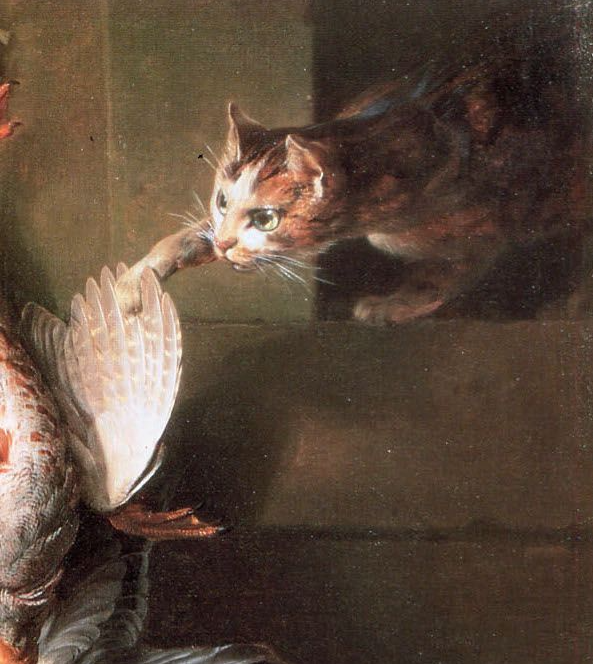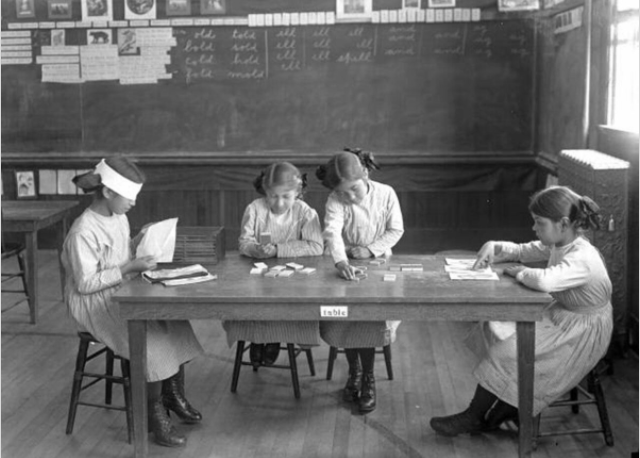A Knowing Cat
By Anonymous
Annotations by Karen Kilcup

late 17th-early 18th century. Public Domain.
A blind girl in a hospital had learned to feed herself, and at meal times a tray containing her dinner was placed on her knees. One day while she was eating, the pet cat of the establishment placed herself before the girl and looked long and earnestly at her, so earnestly that the attendant, fearing the animal meditated some mischief, took her out of the room. Again, the next day, at the same hour, the cat entered the room, but this time walked quietly to the girl’s side, reared herself on her hind legs, and noiselessly reached out her paw to the plate, seized a morsel that pleased her, and, silently as she came, departed to enjoy her stolen meal. The girl never missed her loss, and when told of it by her companions laughed heartily. It is evident that the cat, from observation, had entirely satisfied herself that the girl could not see, and by a process of reasoning decided she could steal a good dinner by this practical use of knowledge.

Courtesy J. A. Juleen / Everett Public Library’s Northwest History Room.
Anonymous. “A Knowing Cat.” The Youth’s Companion: A Juvenile Monthly Magazine Published for the Benefit of the Puget Sound Indian Missions 2, no. 1 (July 1881): 39.
Contexts
Begun in 1881, The Youth’s Companion—a name that many nineteenth-century publications shared—was a monthly student magazine that published articles written by pupils of the Catholic-run boarding school located on the Tulalip Indian Reservation. A federally recognized tribe located in the mid-Puget Sound area, the Tulalip Tribes received reservation lands—22,000 acres—in 1855, with its legal boundaries established by President Ulysses S. Grant in 1873. According to the Tulalip Tribes website, “it was created to provide a permanent home for the Snohomish, Snoqualmie, Skagit, Suiattle, Samish, and Stillaguamish Tribes and allied bands living in the region.”
Nineteenth-century Indian boarding schools aimed to assimilate Native Americans into white culture. They separated children from their families, required students to dress like white Americans, and prohibited them from speaking their language. They also emphasized so-called “industrial” training: boys learned agricultural and industrial skills, while girls learned how to cook, sew, and clean a household. Students were often expected to become servants or to provide manual labor help for whites.
“A Knowing Cat,” like many contributions to Native American student periodicals, was published anonymously. Students living on reservations during this time often received educations governed by white religious authorities who emphasized moral training. This story represents a significant change from the didactic texts that students were normally expected to compose. It showcases feline intelligence, a common theme in nineteenth-century American children’s writing.
Resources for Further Study
- Kalliber, Kim, “Seattle Continues Healing ‘Deep Wounds’ With Boarding School Resolution,” Tulalip News, October 20, 2015.
- King, Marsha. “Tribes confront painful legacy of Indian boarding schools,” Seattle Times,February 3, 2008.
- Marr, Carolyn J. “Assimilation Through Education: Indian Boarding Schools in the Pacific Northwest,” University of Washington Libraries Digital Collection. This article includes historical contexts and features “A Typical Daily Schedule.”
- ———. “Between Two Worlds: Experiences at the Tulalip Indian Boarding School, 1905-1932,” Hibulb Cultural Center & Natural History Preserve.
Contemporary Connections
“Tulalip History Minute 04—The Tulalip Indian School presented by Mary Jane Topash,” the Tulalip History Project. Provides Tulalip-sponsored background on the tribe. “Editorial: Getting to the truth of Tulalip boarding school,” September 26, 2021, HeraldNet (Everett, Washington). Caution: includes information about abuses at the school.